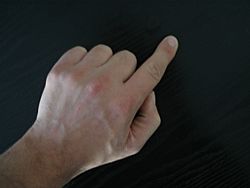Index finger facts for kids
Quick facts for kids Index finger |
|
|---|---|
 |
|
| Left human hand with index finger extended | |
| Latin | Digitus II manus, digitus secundus manus, index |
| Artery | Radial artery of index finger, proper palmar digital arteries, dorsal digital arteries |
| Vein | Palmar digital veins, dorsal digital veins |
| Nerve | Dorsal digital nerves of radial nerve, proper palmar digital nerves of median nerve |
The index finger (also known as forefinger or pointer finger) is the second digit on your hand. It is located between your thumb and your middle finger. This finger is usually the most skillful and sensitive one on your hand. However, it is not the longest. It is shorter than the middle finger. It can be shorter or longer than your ring finger.
Contents
What is the Index Finger?
The name "index finger" literally means "pointing finger." This comes from the Latin word indicate, which means to show or point out. Its scientific names are "index finger" and "second digit."
Parts of the Index Finger
Your index finger has three phalanges, which are the bones that make up your fingers. The finger itself does not have any muscles. Instead, it is controlled by muscles located in your hand. These muscles connect to the finger bones through strong cords called tendons.
How We Use Our Index Finger
We use our index finger in many ways every day.
Showing Numbers and Warnings
A single index finger held straight up often shows the number one. However, how people count with their fingers can be different in various cultures. When you hold your index finger up or move it side to side (like wagging it), it can be a way to warn someone or tell them "no."
In the American Sign Language alphabet, if you hold your hand with your palm out and your thumb and middle fingers touching, your index finger forms the letter 'd'.
Pointing to Show Things
Pointing with your index finger is a common way to show or identify something. This could be an item, a person, a place, or an object.
Babies often start pointing around one year old. They use pointing to share complex thoughts. This includes showing interest, what they want, or giving information. When human babies point, it can show their theory of mind. This is their ability to understand what other people are thinking. This simple gesture might have helped human language develop.
Most non-human primates do not point in complex ways. This is because they cannot easily understand what others are thinking. However, some animals like crows, dogs, and elephants can understand when a human points.
In some cultures, like among the Malay and Javanese people in Southeast Asia, pointing with the index finger is considered rude. In these places, people often use their thumb to point instead.
The Index Finger in Islam
In the religion of Islam, raising the index finger shows the Tawhīd. This means the complete oneness of God. It is used to express that "there is no god but Allah."
In Arabic, the index finger is called musabbiḥa. This word is related to the Arabic verb sabbaḥa, which means to praise or glorify God. People do this by saying "Subḥāna Allāh" (Glory be to God).
The Index Finger in Ancient Times
Before modern tools like GPS and compasses, ancient humans used their index finger to find directions. At night, they would point to objects in the sky, like stars, to guide them.
Index Finger in Art
In art, an index finger pointing at the viewer often means a command or a call to action. Two famous examples are recruiting posters from World War I in the United Kingdom and the United States.

Recruitment poster, James Montgomery Flagg, 1917
|
An index finger pointing up can also show teaching authority. This is seen in the painting The School of Athens by Raphael. In this artwork, the philosopher Plato is shown pointing upwards.

A detail from The Creation of Adam, Michelangelo, 1512
|
See also
 In Spanish: Dedo índice para niños
In Spanish: Dedo índice para niños




